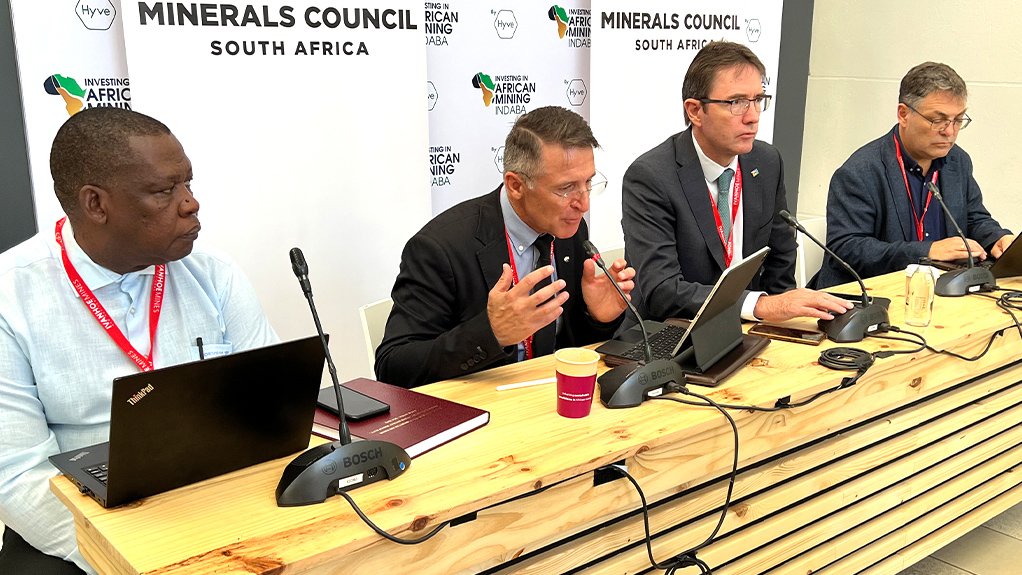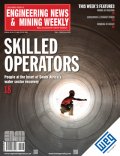Trackless mobile machine safety next big challenge, says Minerals Council


From left to right, Nikisi Lesufi, Japie Fullard, Roger Baxter and Allan Seccombe.
JOHANNESBURG (miningweekly.com) – Having last year achieved the lowest fall of ground fatalities ever, South African mining’s next big safety challenge is to achieve greater safety in the use of trackless mobile machines – rubber-tired vehicles that operate in underground mines without making use of rail tracks.
In 2021, South African mining suffered 16 trackless mobile machine-related fatalities – and last year that worsened to 17.
“We’re going to do whatever we can to bring that down,” says Minerals Council South Africa chairperson Zero Harm Forum Japie Fullard, who was speaking to journalists in the media lounge of the Investing in African Mining Indaba, together with outgoing Minerals Council CEO Roger Baxter and Minerals Council senior executive environment, health and legacies Nikisi Lesufi.
Following constructive collaboration, 2015 regulations governing trackless machines have now been uplifted, and the Mine Health and Safety Act Trackless Mobile Machinery Regulations for collision avoidance systems promulgated.
“It means we must now get into forward-march mode,” says Fullard.
Trackless mobile machinery is now a very big focal point, and Baxter reports considerable progress in the adoption of collision avoidance systems. Also at the Mining Indaba, South Africa’s Council for Scientific and Industrial Research showcased a data-driven solution to eliminate trackless mobile machinery-linked transport injuries.
SIX FALL OF GROUND FATALITIES
In 2007, fall-of-ground incidents alone claimed 76 lives. Last year, this was cut down to six.
In 1992, the year Baxter joined the mining sector, the industry suffered 615 fatalities.
It has had a 90%-plus reduction since then, a lot of it testament to the adoption of global leading practice, changing people’s mindsets around safety behaviour within operations, legislative change through the Mine Health & Safety Act, and collaboration between the stakeholders through the Mine Health & Safety Council.
The Mine Health & Safety Act was promulgated after the Leon Commission of Enquiry, which took place after the Vaal Reefs disaster in 1995, when a locomotive fell into a lift shaft killing 104 people.
On what must be done to improve the safety of trackless mobile machines, Fullard says three things stand out: the technology itself and its link to mining processes, proper structuring of traffic management plans to ensure operational readiness within mines, and the importance of training.
“If you think that you’re just going to put in technology without upskilling your labour, you are going to have huge problems,” Fullard cautions.
“It’s not just push another button and it will be solved. It’s a process and that’s why we’re all working very hard to get all the companies into line,” he says.
A major focus is on high-potential incidents, which have not yet happened but which have the potential to cause fatality.
“We look at all the things that could have been fatal because that’s where the learnings are and the morale of those learnings is much better because nobody has lost a life. What we can do as the industry before people lose their lives is very important to me,” says Fullard, who emphasises that stopping mining in dangerous places is being incentivised and rewarded.
“If you think about a big mine, that’s 8 000 people going down underground, that’s 8 000 pairs of eyes. If you can get all of them to focus on the hazards, just imagine how safe that place can be. We are talking about people who have been in their roles in the mines for years and years. They’ve got so much experience and empowering them to let us know when they feel uncomfortable is probably one of the biggest breakthroughs that we have had,” Fullard adds.
“We still have 49 people who didn’t get home safely last year. Our focus is zero harm, every mineworker getting home safely every day,” said Fullard.
Indications of 100% collaboration by government, labour and business towards achieving zero harm were reportedly evident during this month’s release of the latest safety statistics.
ENVIRONMENT, HEALTH AND LEGACIES
Performance and the milestones achieved on occupational diseases show a very mixed picture, with improvement in some areas, and stagnation and deterioration in others, says Lesufi.
Owing to the Covid pandemic, in 2020 and 2021 there were disease reporting declines resulting in health statistics being based on 2021 data and not 2022 data.
Currently, the biggest concern is increased over exposure to air pollution and noise, which result in an increase in occupational diseases if unmanaged.
“We are, however, heartened to see that occupational diseases continue to decline from 2018 up to 2021, where tuberculosis – TB – in mining is below the national average.
“In the past, it was always said that the mining industry is the head of the TB snake but now we are below the national average and actually some of the public sector organisations across the continent of Africa contact us on our programmes and initiatives,” says Lesufi.
Responding to Mining Weekly on what is being done to reduce air pollution and noise, he says the Minerals Council has already identified seven leading practices which companies are expected to adopt to manage dust control.
“But the issue is further research, which we are doing, in terms of ensuring whether or not the regulated limits are really effective because when you comply with the regulated limit, you expect no disease emergence, but even if you comply with the regulated dust exposures, you still pick up disease, which means that the regulated limits are not protective enough and we need to do our own research on the estimation to see which limits work, which we can then develop in the industry.
“In terms of noise, we have been doing audits for the last three, four years of identifying noise-limiting equipment within the industry and there is just the question of the maturity and the legacy issues at play here.
“But we’ve got some of the mature mining companies with older equipment, which is not able to be retrofitted to the level of noise that is acceptable but those noises are the same as occupational exposures.
“They are at the right level but they still result in noise-induced hearing loss so that’s why I said we are doing additional research to find out whether the regulated limits are protective or not,” Lesufi points out.
The Minerals Council has the Masoyise health programme, which is probably the blueprint for all the continental chambers of mines. The council works closely with the International Council on Mining and Metals (ICMM), of which South Africa is a constituent component, with several South African mining companies being part of ICMM.
It is also working with its Southern African Development Community counterpart, the Mining Industry Association of Southern Africa (Miasa).
“We have meetings of the Miasa CEOs and we focus our conversation on our performance on health and safety, and we share in the region lessons from each other because in health and safety, incremental progress is made by learning from each other on how you take the ideas and message forward and then how you implement,” says Baxter.
At the Mines Occupational Health and Safety Learning Hub, the focus is on global leading practices that can be applied to help reduce fatalities.
“We’ve had some remarkable successes in doing that, but again, it’s an incremental process, but that incremental process has got us a very long way and now our next big focal point is on general accidents with trackless mining machinery,” says Baxter.
On the health side, he adds that a huge effort is being expended on occupational diseases and legacies.
“We’ve made tremendous strides towards reduction of TB rates in mining, and testing rates for other lifestyle diseases have escalated through a special health programme. Below 50 deaths is a milestone not an achievement and we’ve got a clear goal in mind and that is zero harm,” says Baxter, who a couple of years ago imposed a deliberate come-home safely intervention under the Khumbul'ekhaya campaign.
Comments
Press Office
Announcements
What's On
Subscribe to improve your user experience...
Option 1 (equivalent of R125 a month):
Receive a weekly copy of Creamer Media's Engineering News & Mining Weekly magazine
(print copy for those in South Africa and e-magazine for those outside of South Africa)
Receive daily email newsletters
Access to full search results
Access archive of magazine back copies
Access to Projects in Progress
Access to ONE Research Report of your choice in PDF format
Option 2 (equivalent of R375 a month):
All benefits from Option 1
PLUS
Access to Creamer Media's Research Channel Africa for ALL Research Reports, in PDF format, on various industrial and mining sectors
including Electricity; Water; Energy Transition; Hydrogen; Roads, Rail and Ports; Coal; Gold; Platinum; Battery Metals; etc.
Already a subscriber?
Forgotten your password?
Receive weekly copy of Creamer Media's Engineering News & Mining Weekly magazine (print copy for those in South Africa and e-magazine for those outside of South Africa)
➕
Recieve daily email newsletters
➕
Access to full search results
➕
Access archive of magazine back copies
➕
Access to Projects in Progress
➕
Access to ONE Research Report of your choice in PDF format
RESEARCH CHANNEL AFRICA
R4500 (equivalent of R375 a month)
SUBSCRIBEAll benefits from Option 1
➕
Access to Creamer Media's Research Channel Africa for ALL Research Reports on various industrial and mining sectors, in PDF format, including on:
Electricity
➕
Water
➕
Energy Transition
➕
Hydrogen
➕
Roads, Rail and Ports
➕
Coal
➕
Gold
➕
Platinum
➕
Battery Metals
➕
etc.
Receive all benefits from Option 1 or Option 2 delivered to numerous people at your company
➕
Multiple User names and Passwords for simultaneous log-ins
➕
Intranet integration access to all in your organisation



















